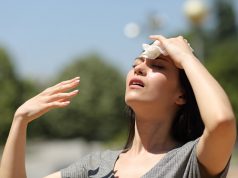Exploring the benefits with Dr. Tarek Tanbouli
By Francesca Sullivan
Abdel Aziz Sayar emerges from his ozone treatment in a private clinic in Mohandessin, keen to extoll the virtues of a form of therapy that is not only unfamiliar to the majority of people, but also viewed with suspicion by much of the medical establishment. Can the results speak for themselves? Sayar is a long term sufferer of both hepatitis C, and acute osteo-arthritis, but he is adamant that discovering the benefits of ozone therapy has changed his life.
“The modern medical treatment for hepatitis C, interferon, has devastating side effects, and after it had destroyed my immune system and left me feeling suicidal, I refused it. Instead I was seeing a herbal medicine specialist, but when he died (in an accident) I began to do my own research on other alternative treatments and discovered to my surprise that ozone therapy was available here in Egypt. After just six treatments I began to feel the benefits. When I arrived at the clinic my palms were dark red” – he turns them up to be examined. “Now my skin is a normal colour again. And much more than that, I got my life back. I used to suffer extreme fatigue every day. Now I have energy.”
His relief from neck and shoulder arthritis was also so remarkable that he persuaded his wife, a fellow sufferer, to have the treatment too. “I had a four-year-old sprain to my ankle that hadn’t healed properly as well as arthritis symptoms,” Sayar’s wife tells Cairo East Magazine. “After just a few ozone treatments I was able to stop taking the anti-inflammatory drugs that have long term negative side effects, and my ankle has healed.”
So what is this new therapy that brings so much benefit to chronic conditions? In fact it is not new at all; as far back as the 1870’s ozone – essentially an activated form of oxygen, or a reactive oxygen atom – was identified as having anti-bacterial properties and was used in the treatment of wounds on the battlefield, and in conjunction with steam as a relaxant – a treatment available today in some spas and wellness centres. It is also used nowadays in swimming pools and water treatment plants as a less toxic alternative to chlorine. We know that the ozone layer around the earth protects us from harmful solar rays, and increased levels of ozone at the seaside contribute to our sense of well-being. Yet it can also have potentially harmful effects when not administered properly. Therapeutic ozone is created in a generator that electrically activates the oxygen, effectively harnessing it for specific uses.
Claims for ozone as a possible treatment for a variety of diseases ranging from tuberculosis to cancer go back more than a century, but have been refuted by the FDA in the US as un-proven. Dr Taha Tarek Tanbouli, a leading pioneer and researcher into the use of ozone therapy in Egypt, points out however that this is not surprising.
“Ozone therapy offers a much cheaper alternative to drugs such as interferon,” he says. “The drug companies aren’t keen!”
Dr Tanbouli not only offers ozone therapy at his clinic, but has also worked with the Ministry of Health in a test project on hepatitis patients at the Haram Hospital. The fact that they decided the results were inconclusive does not deter him one bit. “The experiment was only carried out for three months as opposed to the required six,” he says. “Even in that shortened time 58 per cent of patients had a seven grade improvement of fibrosis of the liver, and although the virus was not removed the chances of the patients going to liver failure were irrefutably reduced. It isn’t always necessary to get a negative virus result, what is important is that the patient feels better, and has better liver function.”
Dr. Tanbouli has gone on to continue his own research into the benefits of ozone therapy in another important area: obstetrics. “My research, along with my medical colleague Professor Nabil Mawsouf, has been in increasing the foetal weight of babies whose mothers have hypertension. I administered the treatment to both my granddaughters during my own daughter’s eighth month of each of her pregnancies, to improve placental blood flow. The results were very positive.”
The pros and cons of ozone therapy seem to see-saw according to different research. A recent article in the UK press highlighted tests in Germany – which has led the field in this area of medicine – showing the benefits to sufferers of chronic spinal disc problems. At the very least, a complementary treatment that reduces the long-term intake of potentially harmful drugs seems worth trying.
We put a few questions to Dr. Tanbouli about what to expect from a treatment.
CEM: What conditions do you most commonly treat?
TT: No treatment can compare with ozone for enhancing the dilation of blood vessels. It increases the blood flow from 50% to 75%, and allows the red blood cells to carry more oxygen, as well as helping to regulate the blood’s normal liquidity. Therefore any condition of the circulatory and vascular system will benefit. Also disease caused by viruses, such as hepatitis and herpes respond well. Fungal infections such as chronic thrush, inflammatory joint, arthritic and rheumatic conditions, chronic skin conditions, immunodeficiency diseases, are all candidates, as well as more simple applications such as relaxation and better sleep.
What form does the treatment take?
Treatment is administered in different ways according to the condition. Rectal insufflation (introduced painlessly through a rectal tube the ozone is absorbed by the stomach lining), major auto-haemo therapy (100 cc of ozone is added to a blood collecting bag and re-infused into the body), minor auto-haemo therapy (the ozone is mixed into 33cc of blood, shaken vigorously to destroy the red blood cells and injected intra-muscularly), by local subcutaneous injection at the point of pain for joints and ulcers, as a steam bath absorbed through the pores for skin conditions, and as a combination with prolotherapy (injection of glucose) called ‘prolozone’, for joint pain.
One way that it cannot be taken is through the lungs; this is dangerous.
Is it suitable for everyone, or are there any conditions that it is prohibited for?
Favism – we test for this before treatment. Also goitre disease and an over-active thyroid; it will increase the problem.
Can ozone therapy be used in conjunction with other forms of treatment?
Yes, it is perfectly OK to take it as a complementary therapy. With inflammatory conditions some patients say they cannot live without their anti-inflammatory drugs. We tell them, begin with both then gradually go off the pills. It may be that you will need to come in every few months for booster treatments, and sometimes go back to the drugs for short periods, but this is much better than risking the long term effects such drugs can cause.
How many sessions are required, and what does it cost?
It depends on what kind of treatment and what it is for. But for example for a liver disease like hepatitis you may need to spend two or three thousand pounds every six months having treatments. Per year this is much less than you would spend on buying conventional drug treatment. A blood treatment costs the same as an hour’s session in the steam sauna (190 EGP), but some treatments are as little as 80 EGP.
Before I leave Dr. Tanbouli’s clinic, I take up his offer to sample an hour in the steam cabinet, absorbing regulated ozone through the pores in my skin. You don’t need to have a medical complaint to benefit from this deluxe form of sauna; within fifteen minutes any slight aches and pains in my muscles from exercise had melted away, and I almost nodded off to sleep, emerging an hour later feeling super-relaxed. Any form of complementary medicine may require a leap of faith to believe in its benefits, but for many patients who swear by ozone, it has been a last resort which ended up a lasting life-enhancer.





